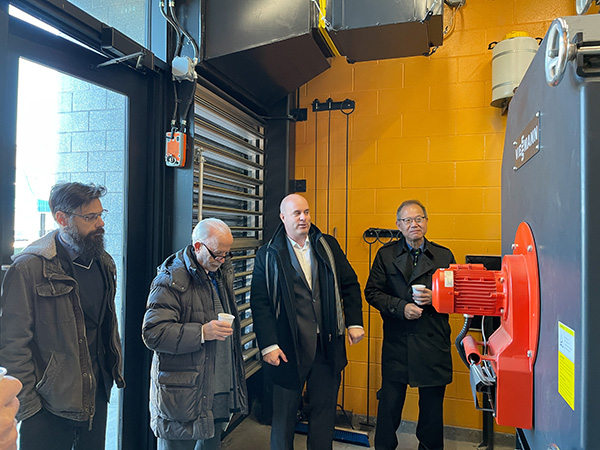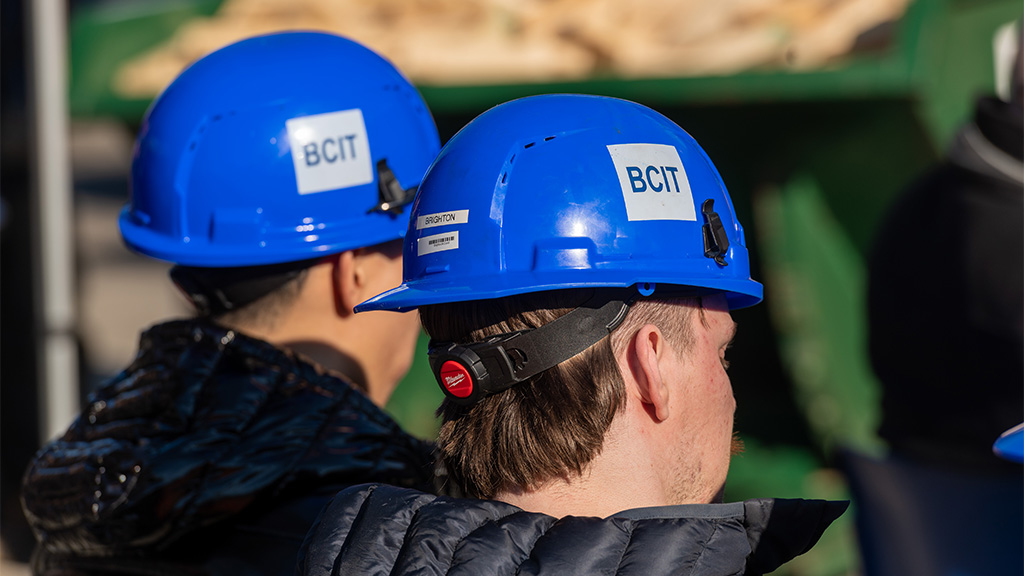The British Columbia Institute of Technology (BCIT) has opened a new $1.5 million wood waste to energy centre (WWEC).
The facility, which had its official opening in December 2022, is producing energy now on its Burnaby campus.
Selina Liu, BCIT’s campus planning and facilities energy manager, says the centre will use 250 tons of wood cut-offs per year to heat two buildings on the campus.
“The centre serves two buildings in the northeast corner of BCIT that belong to the School of Construction and the Environment, the joinery shop and the carpentry shop, each about 2,000 square metres in area,” says Liu.
There are three parts to the WWEC operation.
The system starts off with clean, kiln-dried lumber cut-offs from the joinery and carpentry shops that are sent to a chipper where they are cut into inch-long chips.
The chips are stored in a silo and fed into the fires of a biomass boiler by an auger.
The burning wood chips heat the water in the boiler, and the hot water is then piped to two nearby buildings — NE2 and NE4.
Fan unit heaters blow air over hot water coils, which deliver warm air back to the carpentry and joinery shops.
Exhaust from the boiler is run through a multi-stage filter to ensure it meets Metro Vancouver Regional District’s emissions regulations.
Liu says the WWEC has several environmental benefits.

“It will eliminate 75 tons of greenhouse gas (GHG) emissions every year,” says Liu. “It also means BCIT doesn’t have to buy carbon offsets, or natural gas to power the boiler, or pay to have the waste trucked away.”
Liu says the facility, which cost $1 million, will save BCIT an estimated $20,000 to $30,000 per year.
“In the future, it can expand to three times its current size, which will enable it to serve more buildings on the campus,” she says.
The project is a partnership between BCIT Campus Planning and Facilities and the BCIT School of Construction and the Environment.
“The idea originated in the construction school,” says Liu. “It was looking for a way to make use of its wood waste, and it got the project off the ground. The centre is run by campus planning and facilities.”
BCIT students got involved in the project too.
They built the timber structure for the roof of the boiler house and the steel structure for the chipper enclosure; fixed up the chipper metal hopper; performed the air dispersion modelling that was required to obtain permitting; and completed a noise control study.
Now that the facility is up and running, BCIT students are visiting it to learn how to operate and maintain a biomass-driven pressure vessel.
The WWEC is the last of a series of clean-tech projects that reduced the School of Construction and Environment’s GHG emissions by more than three-quarters in the buildings where it teaches welding, piping, carpentry and joinery.
BCIT is not the only Lower Mainland post-secondary institution to turn wood waste into energy.
The University of British Columbia’s Bioenergy Research and Demonstration Facility (BRDF), located on the university’s Vancouver campus, uses biomass obtained from urban wood waste to generate thermal energy that heats buildings on the UBC campus.
Every day BRDF processes two to three truckloads of ground and chipped waste wood that consists of sawmill residuals, municipal trimmings and the results of land clearing operations.
The facility, which UBC says was the first of its kind in North America, reduces the university’s reliance on fossil fuels, provides one-quarter of the campus’s heating requirements and eliminates 14 per cent of campus greenhouse gas emissions.
BRDF was also one of the first buildings in North America to be constructed from Canadian-produced cross-laminated timber.
Across town in Burnaby, Simon Fraser University’s (SFU) biomass plant transforms wood waste that used to be trucked to the landfill into a low-carbon energy source.
The plant provides heat and hot water to most of the university’s Burnaby Mountain campus and to approximately one-half of the adjacent UniverCity residential development.
SFU expects the new $33-million Corix biomass plant will reduce GHG emissions by 80 per cent now that it has begun operating.
The university says the GHG the plant saves every year is the equivalent of the emissions from 900 homes.
SFU says it has one of the smallest GHG footprints of any university in Canada.
The facility will enable the university to attain 97 per cent of British Columbia’s 2050 greenhouse gas target, making SFU a leader in the Canadian public sector in reducing GHG emissions, says chief facilities officer Larry Waddell in a statement.









Recent Comments
comments for this post are closed